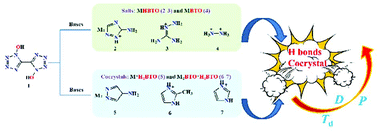Novel strategies for synthesizing energetic materials based on BTO with improved performances†
Abstract
The layer-by-layer assembly of molecules is ubiquitous in nature. Highly ordered structures formed in this manner often exhibit fascinating material properties. A layer hydrogen bonding pairing approach allows the development of tunable energetic materials with targeted properties. A series of unusual energetic compounds based on 1H,1′H-5,5′-bistetrazole-1,1′-diolate (1), such as the salts of 3-amino-1,2,4-triazolium (2), aminoguanidinium (3), and hydrazinium (4), and the cocrystals of 4-amino-1H-pyrazole (5), 2-methylimidazole (6), and imidazole (7), were synthesized using this strategy. The structures of the obtained products 2–7 were fully characterized by elemental analysis, IR spectroscopy, 1H NMR and 13C NMR spectroscopy, and single-crystal X-ray analysis. Their thermal decomposition behavior was studied by differential scanning calorimetry and thermogravimetry. Their mechanical sensitivities and detonation performances were also analyzed in detail. Results show that products 2–7 exhibit higher density, better detonation performances, and more excellent sensitivities than those of the same species of cation salts previously reported.



 Please wait while we load your content...
Please wait while we load your content...